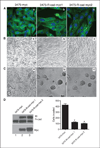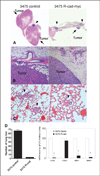Loss of retinal cadherin facilitates mammary tumor progression and metastasis
- PMID: 19491271
- PMCID: PMC4382672
- DOI: 10.1158/0008-5472.CAN-08-4007
Loss of retinal cadherin facilitates mammary tumor progression and metastasis
Abstract
The mammary epithelium is thought to be stabilized by cell-cell adhesion mediated mainly by E-cadherin (E-cad). Here, we show that another cadherin, retinal cadherin (R-cad), is critical for maintenance of the epithelial phenotype. R-cad is expressed in nontransformed mammary epithelium but absent from tumorigenic cell lines. In vivo, R-cad was prominently expressed in the epithelium of both ducts and lobules. In human breast cancer, R-cad was down-regulated with tumor progression, with high expression in ductal carcinoma in situ and reduced expression in invasive duct carcinomas. By comparison, E-cad expression persisted in invasive breast tumors and cell lines where R-cad was lost. Consistent with these findings, R-cad knockdown in normal mammary epithelium stimulated invasiveness and disrupted formation of acini despite continued E-cad expression. Conversely, R-cad overexpression in aggressive cell lines induced glandular morphogenesis and inhibited invasiveness, tumor formation, and lung colonization. R-cad also suppressed the matrix metalloproteinase 1 (MMP1), MMP2, and cyclooxygenase 2 gene expression associated with pulmonary metastasis. The data suggest that R-cad is an adhesion molecule of the mammary epithelium, which acts as a critical regulator of the normal phenotype. As a result, R-cad loss contributes to epithelial suppression and metastatic progression.
Conflict of interest statement
No potential conflicts of interest were disclosed.
Figures






Similar articles
-
Twist, a master regulator of morphogenesis, plays an essential role in tumor metastasis.Cell. 2004 Jun 25;117(7):927-39. doi: 10.1016/j.cell.2004.06.006. Cell. 2004. PMID: 15210113
-
Cadherin and catenin expression in normal human bronchial epithelium and non-small cell lung cancer.Lung Cancer. 1999 Jun;24(3):157-68. doi: 10.1016/s0169-5002(99)00032-x. Lung Cancer. 1999. PMID: 10460003
-
Metastasis tumor antigen family proteins during breast cancer progression and metastasis in a reliable mouse model for human breast cancer.Clin Cancer Res. 2006 Mar 1;12(5):1479-86. doi: 10.1158/1078-0432.CCR-05-1519. Clin Cancer Res. 2006. PMID: 16533771
-
The role of cadherin-mediated adhesion in breast cancer.J Mammary Gland Biol Neoplasia. 1996 Apr;1(2):219-29. doi: 10.1007/BF02013645. J Mammary Gland Biol Neoplasia. 1996. PMID: 10887495 Review.
-
Cadherin junctions in mammary tumors.J Mammary Gland Biol Neoplasia. 2001 Jul;6(3):275-85. doi: 10.1023/a:1011319507155. J Mammary Gland Biol Neoplasia. 2001. PMID: 11547897 Review.
Cited by
-
Association of environmental exposure to chromium with differential DNA methylation: An epigenome-wide study.Front Genet. 2023 Jan 4;13:1043486. doi: 10.3389/fgene.2022.1043486. eCollection 2022. Front Genet. 2023. PMID: 36685967 Free PMC article.
-
Loss of breast epithelial marker hCLCA2 promotes epithelial-to-mesenchymal transition and indicates higher risk of metastasis.Oncogene. 2012 Apr 26;31(17):2237-46. doi: 10.1038/onc.2011.392. Epub 2011 Sep 12. Oncogene. 2012. PMID: 21909135 Free PMC article.
-
Cdh4 Down-Regulation Impairs in Vivo Infiltration and Malignancy in Patients Derived Glioblastoma Cells.Int J Mol Sci. 2019 Aug 18;20(16):4028. doi: 10.3390/ijms20164028. Int J Mol Sci. 2019. PMID: 31426573 Free PMC article.
-
N-cadherin regulates mammary tumor cell migration through Akt3 suppression.Oncogene. 2013 Jan 24;32(4):422-30. doi: 10.1038/onc.2012.65. Epub 2012 Mar 12. Oncogene. 2013. PMID: 22410780 Free PMC article.
-
A cadherin switch underlies malignancy in high-grade gliomas.Oncogene. 2015 Apr 9;34(15):1991-2002. doi: 10.1038/onc.2014.122. Epub 2014 May 26. Oncogene. 2015. PMID: 24858041
References
-
- Fraga MF, Herranz M, Espada J, et al. A mouse skin multistage carcinogenesis model reflects the aberrant DNA methylation patterns of human tumors. Cancer Res. 2004;64:5527–5534. - PubMed
-
- Bracke M, Roy FV, Mareel M. The E-cadherin/catenin complex in invasion and metastasis. In: Gunthert U, Birchmeier W, editors. Attempts to Understand Metastasis Formation I Metastasis-related molecules. Berlin: Springer; 1996. pp. 123–161.
-
- Christofori G, Semb H. The role of the cell-adhesion molecule E-cadherin as a tumour-suppressor gene. Trends Biochem Sci. 1999;24:73–76. - PubMed
-
- Vleminckx K, Vakaet L, Jr, Mareel M, Fiers W, van Roy F. Genetic manipulation of E-cadherin expression by epithelial tumor cells reveals an invasion suppressor role. Cell. 1991;66:107–119. - PubMed
Publication types
MeSH terms
Substances
Grants and funding
LinkOut - more resources
Full Text Sources
Research Materials
Miscellaneous

